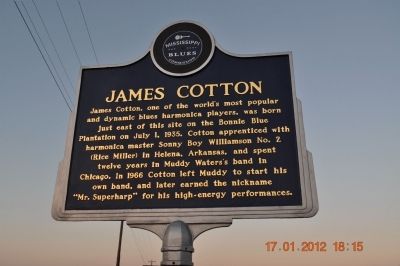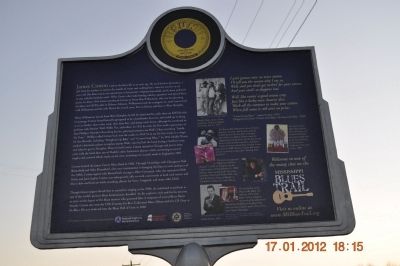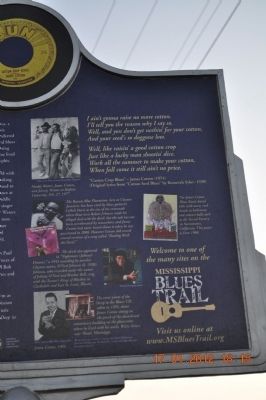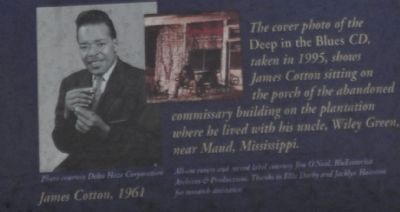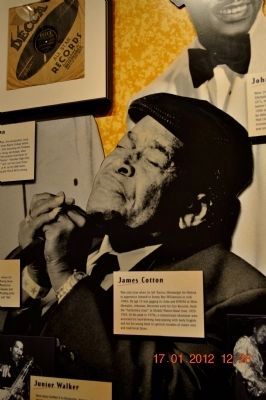Tunica in Tunica County, Mississippi — The American South (East South Central)
James Cotton
(Back):
James Cotton took to the blues life at an early age. He used his first harmonica, a gift from his mother, to imitate the sounds of trains and cackling hens, when he was five or six years old. But blues music was unwelcome in his parents’ religious household, and Cotton preferred to stay with his bachelor uncle, Wiley Green, who made bootleg whiskey, gambled, and played blues piano. In about 1944 Green introduced Cotton to Sonny Boy Williamson, who was broadcasting the blues over KFFA radio in Helena, Arkansas. Williamson took the youngster in, and Cotton lived with Williamson and his wife Mattie for several years, first in Helena and then in West Memphis. When Williamson moved from West Memphis, he left his band and his radio show on KWEM with his protege. Cotton found himself unprepared to be a bandleader, however, and ended up working as an ice hauler, short order cook, shoe shine boy, and dump truck driver, although he continued to perform with Howlin’ Wolf, Willie Nix, and others. In 1952 he made his first studio appearance at Sam Phillips’s Memphis Recording Service, playing harmonica on Wolf’s Chess recording “Saddle My Pony.” Phillips called Cotton back into the studio in 1953-54 to cut his first tracks as a singer for Sun Records, including “Straighten Up Baby” and “Cotton Crop Blues.” In 1954 Muddy Waters needed a harmonica player to replace Junior Wells, who had left the band during a Southern tour, and when he got to Memphis, Waters hired Cotton. Cotton moved to Chicago and put in more years with the band than any of Muddy’s other harmonica players, while continuing to record singles and assorted album tracks on his own, including two records made in England in 1961. Cotton formed the James Cotton Blues Band in 1966. Through friendships with Chicagoans Paul Butterfield and Mike Bloomfield, who were instrumental in bringing the blues to rock audiences of the 1960s, Cotton signed with Butterfield’s manager, Albert Grossman, who also represented Bob Dylan and Janis Joplin. Cotton was subsequently able to work consistently at both rock venues and blues clubs and festivals while recording albums for Verve, Vanguard, and many other labels. Though throat surgery forced him to curtail his singing in the 1990s, he continued to perform as one of the world’s premier blues harmonicists, heralded for his explosive style and for his mission to carry on the legacy of the blues masters who groomed him. A recipient of several Blues Music Awards, Cotton also won the 1996 Grammy for Best Traditional Blues Album with his CD Deep in the Blues. He was inducted into the Blues Hall of Fame in 2006.
Erected 2008 by the Mississippi Blues Commission. (Marker Number 30.)
Topics and series. This historical marker is listed in these topic lists: African Americans • Arts, Letters, Music • Entertainment. In addition, it is included in the Grammy Award Winners, and the Mississippi Blues Trail series lists. A significant historical date for this entry is July 1, 1935.
Location. 34° 35.859′ N, 90° 23.947′ W. Marker is in Tunica, Mississippi, in Tunica County. Marker is at the intersection of Bonnie Blue Road and U.S. 61 on Bonnie Blue Road. Touch for map. Marker is in this post office area: Tunica MS 38676, United States of America. Touch for directions.
Other nearby markers. At least 8 other markers are within 12 miles of this marker, measured as the crow flies. Evansville Mounds (approx. 3 miles away); Town of Tunica Veterans Memorial (approx. 6.2 miles away); Harold "Hardface" Clanton (approx. 6.3 miles away); Johnson Cemetery Mound (approx. 10.1 miles away); "Livin' at Lula" (approx. 11 miles away); Hernando De Soto Commemorative Bridge (approx. 11.2 miles away); Pippengerville (approx. 11.3 miles away in Arkansas); Fight at the Levee (approx. 11.4 miles away in Arkansas). Touch for a list and map of all markers in Tunica.
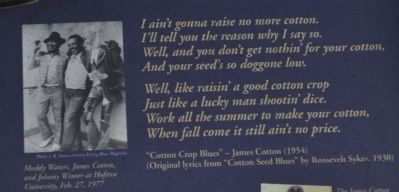
Photographed By Sandra Hughes, January 17, 2012
5. Muddy Waters, James Cotton, and Johnny Winter at Hofstra University, Feb. 27, 1977
I ain't gonna raise no more cotton.
I'll tell you the reason why I say so.
Well, and you don't get nothin' for your cotton,
And your seed's so doggone low.
Well, like raisin' a good cotton crop
Just like a lucky man shootin' dice.
Work all the summer to make your cotton,
When fall come it still ain't no price.
"Cotton Crop Blues" -James Cotton (1954)
(Original lyrics from "Cotton Seed Blues" By Roosevelt Sykes, 1930)

Photographed By Sandra Hughes, January 17, 2012
6. James Cotton Marker
The Bonnie Blue Plantation, here at Clayton Junction has been cited by blues guitarist CeDell Davis as the site of the crossroads where blues icon Robert Johnson made his alleged deal with the devil, but the tale has not been corroborated by researchers, and James Cotton never heard about it when was questioned in 2008. However Cotton did record several versions of a song called "Dealing With the Devil."
The James Cotton Blues Band shared bills with many rock bands at ballrooms and concert halls such as the Sound Factory in Sacramento, California. This poster is from 1968.
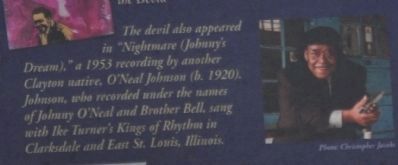
Photographed By Sandra Hughes, January 17, 2012
7. James Cotton Marker
The devil also appeared in "Nightmare (Johnny's Dream)," a 1953 recording by another Clayton native, O'Neal Johnson (b. 1920).
Johnson, who recorded under the names of Johnny O'Neal and Brother Bell, sang with Ike Turner's Kings of Rhythm in Clarksdale and East St. Louis, Illinois.
Credits. This page was last revised on August 30, 2017. It was originally submitted on January 19, 2012, by Sandra Hughes Tidwell of Killen, Alabama, USA. This page has been viewed 1,398 times since then and 48 times this year. Photos: 1, 2, 3, 4, 5, 6, 7, 8, 9. submitted on January 19, 2012, by Sandra Hughes Tidwell of Killen, Alabama, USA. • Craig Swain was the editor who published this page.
